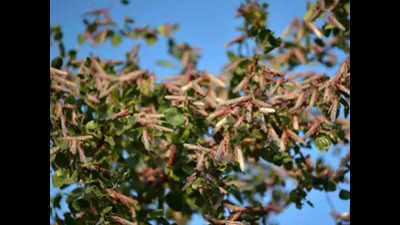- News
- City News
- Hyderabad News
- After locusts invade Maharashtra, officials in Telangana on high alert
Trending
This story is from May 28, 2020
After locusts invade Maharashtra, officials in Telangana on high alert
Agriculture officials in Telangana said the locust invasion in northern India is likely to hit some districts in the state as well. Amaravati in neighbouring Maharashtra, which is already infested, is only 200 km away from Adilabad and officials are on their toes as it won’t take much time for the locusts to head towards northern Telangana, if the wind speed is favourable.

Picture used for representational purpose only
HYDERABAD: Agriculture officials in Telangana said the locust invasion in northern India is likely to hit some districts in the state as well. Amaravati in neighbouring Maharashtra, which is already infested, is only 200 km away from Adilabad and officials are on their toes as it won’t take much time for the locusts to head towards northern Telangana, if the wind speed is favourable.
Collectors of some districts and district agriculture officers have been asked to keep necessary quantities of insecticide ready to counter the locust attack.

Agriculture commissioner B Janardhan Reddy said there was a possibility that the locusts would enter into Telangana if they were not contained in Maharashtra. In particular, Nizamabad, Kamareddy, Mancherial, Jayashankar Bhupalpally, Adilabad and Kumaram Bheem districts have been put on alert.
Normally, the desert locusts are seen in Rajasthan and Gujarat between June and November, but they were spotted by the Union agriculture ministry’s Locust Warning Association in April. A swarm can be made up of 150 million locusts per square km, an expert said.
“A small, one sq km locust swarm can eat the same amount of food in a day as about 35,000 people,” the expert said.
P Chengal Reddy, chief advisor, Consortium of Indian Farmers’ Associations, said the problem could go out of hand if immediate action is not taken. “If they reach Adilabad, the army of locusts will be difficult to handle. With monsoon in early June, they will multiply fast,” Chengal Reddy said.
Reddy, who had a telephonic conversation with farmers’ associations from various parts of the country on Wednesday, urged the Centre to declare the locust invasion as a national calamity.
Collectors of some districts and district agriculture officers have been asked to keep necessary quantities of insecticide ready to counter the locust attack.

Agriculture commissioner B Janardhan Reddy said there was a possibility that the locusts would enter into Telangana if they were not contained in Maharashtra. In particular, Nizamabad, Kamareddy, Mancherial, Jayashankar Bhupalpally, Adilabad and Kumaram Bheem districts have been put on alert.
“This is a real big threat. By June, the population of the locusts is expected to grow by 400 times,” agriculture scientists said. They said the locusts travel at 1.2 km to 1.5 km per hour, prey on crops and cause extensive damage.
Normally, the desert locusts are seen in Rajasthan and Gujarat between June and November, but they were spotted by the Union agriculture ministry’s Locust Warning Association in April. A swarm can be made up of 150 million locusts per square km, an expert said.
“A small, one sq km locust swarm can eat the same amount of food in a day as about 35,000 people,” the expert said.
P Chengal Reddy, chief advisor, Consortium of Indian Farmers’ Associations, said the problem could go out of hand if immediate action is not taken. “If they reach Adilabad, the army of locusts will be difficult to handle. With monsoon in early June, they will multiply fast,” Chengal Reddy said.
Reddy, who had a telephonic conversation with farmers’ associations from various parts of the country on Wednesday, urged the Centre to declare the locust invasion as a national calamity.
End of Article
FOLLOW US ON SOCIAL MEDIA










